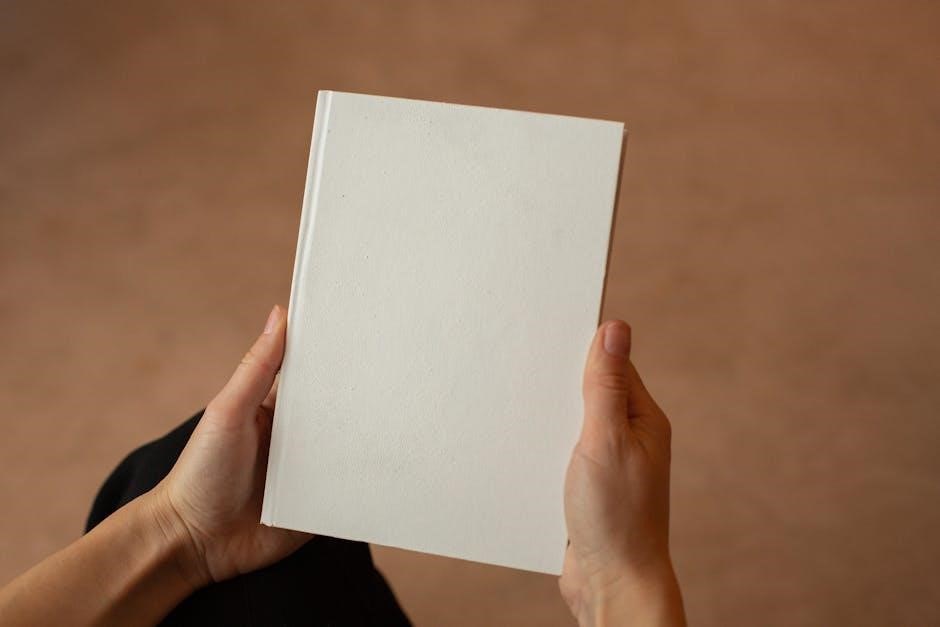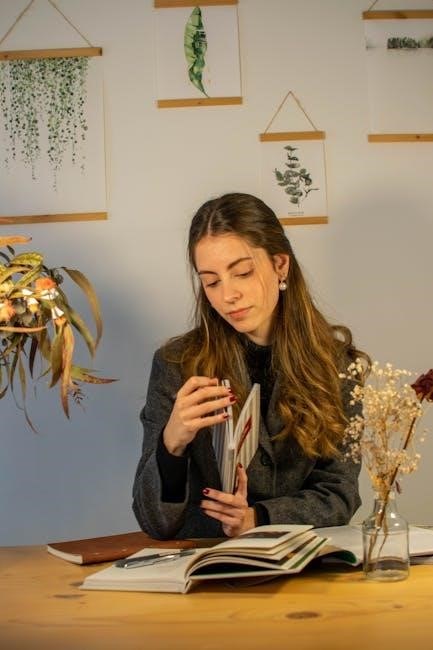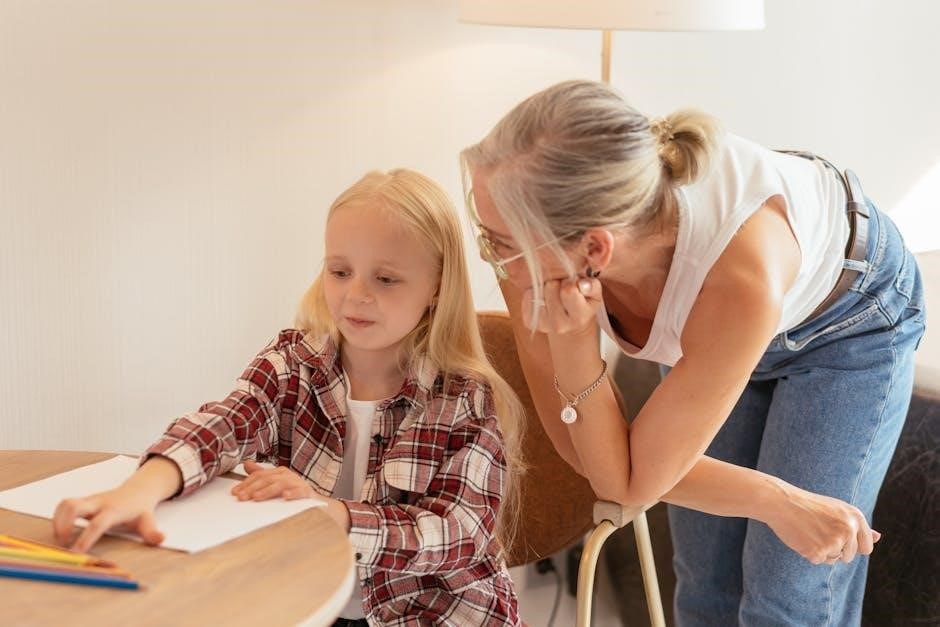Picture prompts are visual tools designed to inspire creativity in writers‚ offering diverse images to spark imagination and encourage self-expression across various genres and themes for both students and educators.
1.1 What Are Picture Prompts?
Picture prompts are visual tools designed to stimulate creativity and inspire writing. They consist of images‚ photographs‚ illustrations‚ or even videos that serve as starting points for stories‚ essays‚ or descriptive writing. These prompts are versatile‚ catering to different age groups and educational levels‚ from elementary to high school students. They can be organized by genre or theme‚ allowing writers to explore various ideas and styles. Picture prompts often overlap in their applications‚ making them adaptable for diverse uses. For example‚ they can be used for short stories‚ journal entries‚ or descriptive writing exercises. Many resources‚ including downloadable PDFs‚ offer these prompts for educators‚ homeschoolers‚ and parents to use in classrooms or personal learning environments. The goal of picture prompts is to unlock creativity‚ improve writing skills‚ and encourage self-expression in a engaging and accessible way. They provide a visual spark that helps writers overcome blank-page syndrome and dive into their imaginations.
1.2 Historical Background of Visual Writing Aids
Visual writing aids have a long history‚ dating back to early forms of communication where images were used to convey stories and ideas. Cave paintings‚ for instance‚ served as primitive visual prompts‚ sparking narratives and cultural traditions. In educational settings‚ visual aids like charts‚ maps‚ and illustrations have been used for centuries to help students engage with material and express their thoughts. The concept of picture prompts as we know it today evolved from these early tools‚ adapting to technological advancements and educational needs. Historically‚ teachers and storytellers relied on visual elements to inspire creativity and facilitate learning. This legacy continues in modern picture prompts‚ which are now widely available in digital formats‚ including PDF resources‚ to cater to diverse learning environments and writing activities. The historical roots of visual writing aids highlight their enduring value in fostering creativity and improving writing skills across generations.
1.3 Evolution in the Digital Age
The digital age has revolutionized the use of picture prompts‚ making them more accessible and versatile than ever before. With the rise of the internet and digital platforms‚ visual writing aids have transitioned from physical materials to downloadable PDFs‚ interactive multimedia‚ and online resources. Educators and writers can now easily access a vast library of images‚ ranging from photographs to illustrations‚ to inspire creative writing. Digital tools have also enabled the creation of interactive prompts‚ where writers can engage with multimedia elements like videos‚ GIFs‚ and even virtual reality scenarios. This evolution has democratized access to visual writing aids‚ allowing educators to tailor prompts to specific learning needs and styles. The ability to share and download picture prompts for creative writing has also fostered collaboration‚ with students and teachers worldwide exchanging ideas and stories. This digital transformation has not only enhanced the versatility of picture prompts but also expanded their reach‚ making them a cornerstone of modern creative writing education.

Benefits of Using Picture Prompts
Picture prompts foster creativity‚ enhance self-expression‚ and improve writing skills. They inspire reluctant writers and provide diverse ideas for stories‚ making the writing process engaging and effective for learners of all ages.
2.1 Enhancing Creativity in Writers
Picture prompts are powerful tools for enhancing creativity in writers by providing visual inspiration that sparks imagination. These images allow writers to interpret and connect with the visuals in unique ways‚ fostering original ideas and diverse perspectives. By presenting a variety of scenes‚ characters‚ and settings‚ picture prompts encourage writers to think outside the box and explore different storytelling angles. They also cater to various genres‚ enabling writers to experiment with new styles and themes. The use of photographs‚ illustrations‚ and even multimedia elements like GIFs or videos adds depth and complexity‚ appealing to different learning styles and creative preferences. Additionally‚ organized prompts by genre or theme provide structure while still allowing for personal interpretation. This approach not only stimulates creativity but also helps writers overcome writer’s block‚ making the writing process more engaging and enjoyable. Examples like those from The New York Times Learning Network demonstrate how image-driven prompts can inspire captivating stories and diverse responses. Furthermore‚ the availability of picture prompt PDFs ensures accessibility for educators and students‚ offering a wide range of creative opportunities. Overall‚ picture prompts serve as a catalyst for imagination‚ helping writers of all ages and skill levels to produce innovative and compelling work.
2.2 Improving Writing Skills Through Visual Cues
Picture prompts are invaluable for improving writing skills by providing visual cues that guide writers in developing descriptive and narrative techniques. These images offer concrete elements for writers to interpret‚ such as settings‚ characters‚ and objects‚ which can be translated into vivid descriptions. By analyzing the details in an image‚ writers enhance their observational skills‚ learning to capture the essence of a scene or emotion. Visual cues also help writers organize their thoughts‚ as they can use the image as a central theme or starting point for their story. This approach encourages the use of sensory language‚ making writing more engaging and immersive. Additionally‚ visual prompts can inspire writers to explore different narrative styles‚ such as first-person or third-person perspectives‚ based on the imagery provided. Over time‚ this practice improves writing clarity‚ structure‚ and overall coherence. Resources like picture prompt PDFs offer curated images designed to target specific writing skills‚ making them a practical tool for educators and students alike.
2.3 Motivating Reluctant Writers with Images
Picture prompts are particularly effective in motivating reluctant writers by leveraging the power of visuals to spark creativity and reduce writing anxiety. For individuals who struggle with initiating written work‚ images provide a tangible starting point‚ making abstract ideas more concrete. The visual cues in picture prompts help writers focus on a specific scene‚ character‚ or object‚ which can inspire ideas and lower the intimidation factor of a blank page. This approach is especially beneficial for students or writers who feel overwhelmed by the pressure to generate ideas independently. By engaging with images‚ reluctant writers can develop a sense of connection to the material‚ fostering a more positive attitude toward writing. Over time‚ this method builds confidence and encourages writers to express their thoughts more freely. Picture prompts also offer a way to cater to diverse learning styles‚ ensuring that all writers‚ regardless of their proficiency level‚ feel inspired and motivated to create.

Types of Picture Prompts
Picture prompts come in various forms‚ including genre-specific‚ thematic‚ and multimedia options‚ catering to diverse writing styles and creative preferences to enhance storytelling and imagination in writers of all levels.

3.1 Genre-Specific Prompts for Diverse Stories
Genre-specific picture prompts are tailored to inspire stories within particular genres‚ such as fantasy‚ romance‚ mystery‚ or sci-fi. These images often feature elements unique to each genre‚ like magical landscapes for fantasy or futuristic cities for sci-fi. By focusing on a specific theme‚ writers can channel their creativity into crafting narratives that align with the genre’s conventions. For example‚ a horror-themed prompt might depict a haunted house or eerie forest‚ encouraging writers to explore suspense and fear. Similarly‚ historical fiction prompts might include images of ancient civilizations or historical events‚ guiding writers to weave authentic and engaging tales. These prompts not only spark imagination but also help writers stay within the boundaries of a genre‚ making them particularly useful for educators teaching genre-specific writing techniques. Additionally‚ they cater to diverse writing styles‚ allowing writers to explore different storytelling approaches while maintaining genre consistency. This focused approach fosters creativity and helps writers develop a deeper understanding of genre-specific storytelling elements.
3.2 Thematic Prompts to Explore Different Ideas
Thematic picture prompts are designed to explore universal ideas‚ emotions‚ or concepts‚ offering writers a versatile starting point for their stories. These prompts often feature images that evoke specific themes‚ such as nature‚ technology‚ or social issues‚ allowing writers to delve into deeper meanings. For example‚ a prompt depicting a serene forest might inspire reflections on solitude or harmony with nature‚ while an image of a bustling city could explore themes of progress or isolation. Thematic prompts encourage writers to think critically about the message or moral they want to convey‚ making them ideal for crafting narratives with emotional or philosophical depth. They also provide flexibility‚ as writers can interpret the same image in countless ways‚ ensuring diverse and creative outcomes. By focusing on themes‚ these prompts help writers connect with broader human experiences‚ fostering empathy and understanding in their stories. This approach makes thematic prompts a powerful tool for both personal and educational writing exercises.
3.3 Visual and Multimedia Prompts for Engagement
Visual and multimedia prompts take creative writing to the next level by incorporating dynamic elements like videos‚ animations‚ or even interactive content. These prompts go beyond static images‚ offering writers a more immersive experience. For instance‚ a short video clip of a bustling marketplace or a time-lapse of a sunset can inspire vivid descriptions and narratives. Multimedia prompts often include sound‚ movement‚ or user interaction‚ which can spark unique ideas and perspectives. They are particularly effective in engaging modern writers who are accustomed to consuming multimedia content. Additionally‚ these prompts can be tailored to different learning styles‚ making them inclusive and accessible. Tools like digital whiteboards or interactive storytelling software allow writers to manipulate the prompts‚ adding their own elements to create personalized narratives. This hands-on approach fosters creativity and makes the writing process more enjoyable. By leveraging technology‚ visual and multimedia prompts redefine traditional storytelling methods‚ offering fresh ways to inspire and engage writers of all ages.

How to Use Picture Prompts Effectively
Picture prompts inspire creativity and engagement by sparking imagination. Use them to guide writers in observing details‚ interpreting scenes‚ and crafting compelling stories. This structured approach fosters analytical thinking and enhances the writing process‚ especially in educational settings.
4.1 Selecting the Right Image for Inspiration
Selecting the right image is crucial for effective picture prompts. The image should be clear‚ visually appealing‚ and relevant to the writing objective. It should evoke emotions‚ raise questions‚ or suggest a story. Consider the audience’s age and skill level when choosing images. For example‚ younger writers might benefit from vibrant‚ whimsical scenes‚ while advanced writers could use complex or abstract visuals. Ensure the image aligns with the desired theme or genre‚ whether it’s fantasy‚ mystery‚ or realism. High-quality images with detail encourage deeper observation and creativity. Avoid overly cluttered or ambiguous pictures that might confuse writers. Provide guidance on interpreting the image‚ such as identifying key elements or imagining the backstory. Tools like stock photo websites or themed galleries can help educators find suitable images. By matching the image to the writer’s needs‚ you maximize its potential to inspire engaging and meaningful stories.
4.2 Conducting Brainstorming Sessions
Brainstorming sessions are a vital step in using picture prompts effectively. Begin by creating a relaxed and open environment where participants feel comfortable sharing ideas. Display the selected image prominently and allow a few moments for observation. Encourage participants to describe what they see‚ feel‚ or interpret from the image. Use open-ended questions like‚ “What could be happening in this scene?” or “What story does this image tell?” to spark creativity. Group discussions can foster collaboration‚ with writers building on each other’s ideas. Emphasize the freedom to explore wild or unconventional notions without judgment. Set a timer to keep the session focused‚ ensuring ideas remain relevant to the image. After brainstorming‚ summarize the key ideas and allow writers to select the direction they find most inspiring. This process bridges the gap between visual inspiration and written expression‚ making the transition to writing seamless and engaging. Effective brainstorming sessions lay the groundwork for compelling narratives.
4.3 Writing the Story: From Prompt to Narrative
Transitioning from a picture prompt to a written narrative requires a structured approach. Start by analyzing the image for key elements such as setting‚ characters‚ and mood. Use these details to craft a compelling opening that immerses the reader in the scene. Develop characters by assigning them motivations and backstories inspired by their appearance or context in the image. Plot development should stem organically from the visual cues‚ ensuring the story remains aligned with the prompt’s essence. Incorporate dialogue and internal monologue to add depth and emotional resonance. As the narrative progresses‚ introduce conflicts or twists that arise from the image’s themes or symbols. Conclude the story with a resolution that ties back to the initial prompt‚ providing closure while leaving room for interpretation. Edit and refine the draft to enhance clarity and coherence‚ ensuring the final narrative is both engaging and faithful to the visual inspiration. This process transforms a static image into a dynamic‚ meaningful story.

Classroom Activities with Picture Prompts
Classroom activities with picture prompts foster creativity and engagement. Techniques such as group storytelling and interactive exercises motivate students to explore ideas and develop their writing skills in a fun‚ collaborative environment.
5.1 Group Storytelling for Collaborative Learning
Group storytelling is a dynamic classroom activity that fosters collaboration and creativity. Students are divided into small groups‚ each given a picture prompt to inspire a shared story. Taking turns‚ they contribute sentences or ideas‚ building a narrative together. This approach encourages teamwork‚ as each member’s input is valued. It also enhances communication skills‚ as students discuss and agree on plot directions. Additionally‚ group storytelling promotes problem-solving‚ as they navigate differing opinions and ideas. Teachers can guide the process by setting a time limit or assigning roles to ensure participation. This activity not only strengthens writing skills but also helps students understand diverse perspectives. The collective effort creates a sense of accomplishment‚ making learning both fun and effective. By integrating visual prompts‚ educators can spark imagination while teaching essential collaborative skills‚ making group storytelling a powerful tool in creative writing education.

5.2 Setting Up Writing Stations
Setting up writing stations is an effective way to create an engaging and structured environment for creative writing. Each station is equipped with a unique picture prompt‚ along with writing materials like paper‚ pens‚ and digital tools. Students rotate through these stations‚ spending a set amount of time at each to craft their responses. This method allows for differentiated instruction‚ as prompts can cater to various genres‚ themes‚ or skill levels. For example‚ one station might feature a fantasy landscape‚ while another displays a mysterious cityscape. Writing stations encourage independence and focus‚ as students work individually or in pairs. Teachers can also include guidance cards at each station to provide writing tips or questions to spark ideas; This setup fosters creativity and adaptability‚ as students engage with diverse visual stimuli. By rotating through stations‚ learners gain exposure to multiple prompts‚ enhancing their ability to think critically and write imaginatively.
5.3 Interactive Exercises to Enhance Participation
Interactive exercises are a powerful way to engage students and encourage active participation in creative writing. One effective approach is to use picture prompts as the foundation for group activities. For example‚ teachers can organize quick writing sprints where students respond to a prompt within a set time‚ fostering spontaneity and creativity. Another idea is to incorporate peer sharing‚ where students exchange their writing based on the same image‚ promoting collaboration and feedback. Additionally‚ interactive exercises like “Write and Pass” can be implemented‚ where students write a sentence or two inspired by the prompt‚ then pass their paper to a neighbor to continue the story. These activities not only enhance participation but also encourage students to think creatively and build on each other’s ideas. By integrating visual and interactive elements‚ educators can create a dynamic and inclusive learning environment that motivates all students to engage with the writing process.
Advanced Techniques for Creative Writing

Advanced techniques involve narrative layering‚ multisensory storytelling‚ and experimental structures. These methods enhance storytelling depth and encourage writers to explore unconventional narrative paths.
6.1 Layering Prompts for Complex Narratives
Layering prompts is an advanced technique that involves combining multiple images or visual elements to create intricate and interconnected storylines. By stacking prompts‚ writers can craft narratives with depth‚ exploring themes‚ emotions‚ and character arcs more profoundly; This method encourages writers to think beyond a single image‚ blending different perspectives or scenarios into one cohesive story. For example‚ a writer might start with a serene landscape‚ then add a mysterious figure‚ followed by an object that holds symbolic meaning. Each layer adds complexity‚ pushing the writer to weave these elements into a unified plot. This technique is particularly effective for developing character backstories‚ subplot integration‚ and thematic resonance. Educators can guide students by providing sequential images or allowing them to curate their own layered prompts‚ fostering creativity and analytical thinking. Layering prompts transforms simple ideas into rich‚ multidimensional narratives‚ making it a powerful tool for advanced creative writing exercises.
6.2 Combining Prompts with Other Media
Combining picture prompts with other media‚ such as music‚ audio clips‚ or even short videos‚ can elevate creative writing to new heights. This multisensory approach engages writers on multiple levels‚ sparking imagination and fostering deeper emotional connections. For instance‚ pairing a haunting image with eerie background music can inspire a suspenseful narrative‚ while a serene landscape accompanied by nature sounds might evoke a peaceful‚ reflective tone. Educators and writers can also experiment with interactive media‚ such as 3D models or virtual reality‚ to immerse themselves in the story’s environment. Additionally‚ incorporating voice recordings or podcasts that describe scenes or characters can provide further inspiration. This technique encourages writers to think beyond static visuals‚ blending auditory and visual cues to create richer‚ more dynamic stories. By integrating diverse media‚ the creative process becomes more engaging‚ leading to innovative and layered narratives that captivate readers.
6.3 Encouraging Sharing and Feedback
Encouraging sharing and feedback is a vital component of using picture prompts effectively in creative writing. By creating a supportive environment‚ writers feel more confident in sharing their work‚ which fosters collaboration and growth. Educators can facilitate this by organizing sharing sessions‚ either in small groups or as a whole class‚ where students discuss their interpretations of the prompts and the stories they’ve written. Peer feedback‚ when guided constructively‚ helps writers gain new perspectives and refine their ideas. Additionally‚ educators can encourage students to share their work online through platforms like blogs or forums‚ reaching a broader audience. This not only builds confidence but also allows writers to see how others interpret the same images. Feedback should be specific and focused on improvement‚ helping writers identify strengths and areas for development. By promoting a culture of sharing and feedback‚ educators empower writers to grow creatively and develop a deeper understanding of their craft.

Resources and Downloads
Explore a variety of picture prompt resources and downloads‚ including PDF guides‚ printable worksheets‚ and interactive templates‚ designed to inspire creative writing. These tools cater to diverse skill levels and interests.
7.1 Finding Picture Prompt PDF Resources
Finding high-quality picture prompt PDF resources for creative writing is easier than ever. Many educational websites‚ creative writing platforms‚ and teacher resource hubs offer free or paid downloadable PDFs specifically designed for writers. Websites like Teachers Pay Teachers and Etsy provide a wide range of themed and customizable picture prompt PDFs‚ catering to different age groups and writing styles.
When searching online‚ use keywords like “picture prompts for creative writing PDF” or “printable picture prompts for students” to find relevant materials. These resources often include high-resolution images‚ writing exercises‚ and prompts organized by genre or theme. Some platforms also offer blank templates‚ allowing users to add their own images for personalized writing sessions.
Additionally‚ many schools and libraries provide picture prompt PDFs as part of their creative writing programs. These resources are designed to inspire imagination and help writers overcome creative blocks. Whether for classroom use or personal projects‚ picture prompt PDFs are a versatile and engaging tool for fostering storytelling skills.
Always ensure that the resources you download are licensed for your intended use‚ especially if you plan to share them with students or colleagues.
7.2 Free vs. Premium Options for Educators

Educators seeking picture prompt PDFs for creative writing have access to both free and premium options. Free resources are widely available online‚ often through educational websites‚ blogs‚ and platforms like Pinterest or Google Drive. These free PDFs typically include a limited set of images and prompts‚ which are still effective for sparking creativity in students. They are ideal for teachers on a budget or those experimenting with picture prompts for the first time.
Premium options‚ however‚ offer more comprehensive and curated content. These paid resources often feature high-resolution images‚ customizable templates‚ and detailed writing exercises tailored to specific age groups or learning objectives. Premium PDFs may also include additional features like lesson plans‚ assessment tools‚ or multimedia elements‚ making them a valuable investment for educators committed to integrating visual storytelling into their curriculum.
When choosing between free and premium options‚ educators should consider their specific needs‚ budget‚ and the desired outcomes for their students.
7.3 Examples and Case Studies of Successful Use
Picture prompts have been successfully implemented in various educational settings to enhance creative writing. For instance‚ a middle school in California used a PDF collection of historical images to inspire students to write short stories based on the past. This approach led to a noticeable improvement in both creativity and historical understanding. Similarly‚ a high school in New York incorporated picture prompts into their curriculum‚ resulting in students producing more detailed and imaginative narratives. Another case study involved an elementary school that used visually engaging prompts to help reluctant writers overcome their fears and develop a love for storytelling.
These examples highlight how picture prompts can be adapted to different age groups and learning environments. They also demonstrate the potential for improving writing skills‚ fostering creativity‚ and making learning more enjoyable for students. Educators can draw inspiration from these success stories to integrate picture prompts effectively into their own teaching practices.

